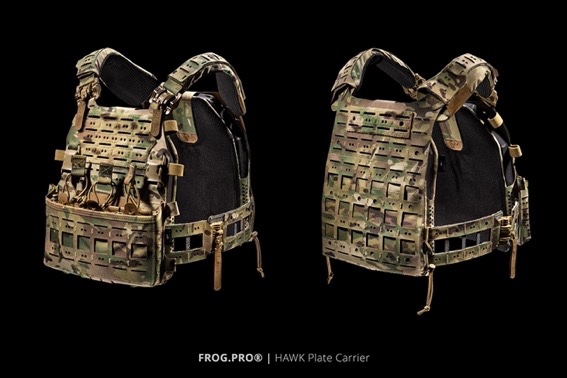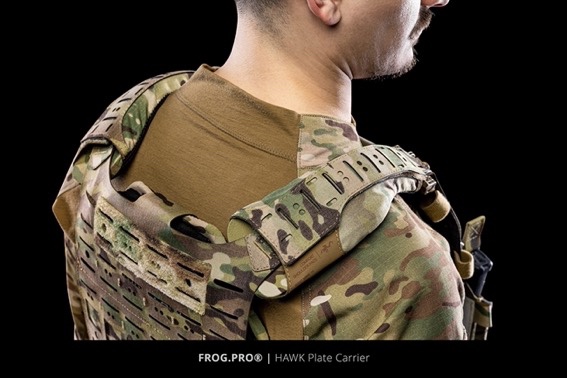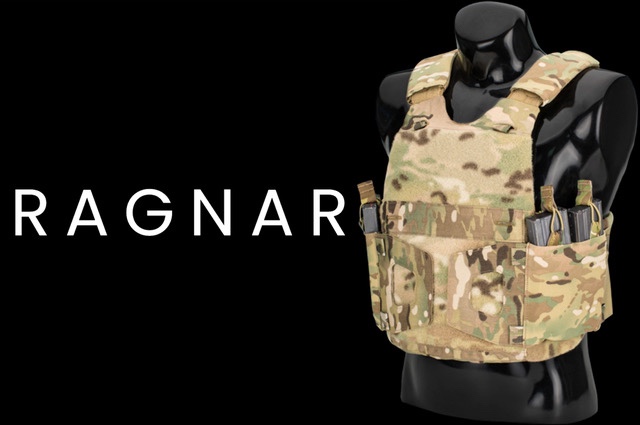(GATTATICO (RE) – ITALY) – FROG.PRO®, the Italian reference brand for tactical tailoring, is proud to announce the launch of its new and long-awaited plate carrier: the HAWK.
“The last years marked big steps in our endless journey towards innovation. After the renovation of our website and our catalogue in 2021, we were still missing a fundamental piece: a new combat plate carrier, that could inherit the place of our previous models and answer the needs of contemporary warfare.
A year-long process of researching and development, supported by the advancing of our machinery and manufacturing techniques that made us reach soaring heights in terms of finishing and performance, finally resulted in a product that we can safely define a combat plate carrier of excellence: the HAWK plate carrier.

For creating the HAWK plate carrier, we took the strength points of its predecessors and reshaped them in a new advanced form.

Like our low-profile ergonomic plate carrier LC-AWPC, the HAWK plate carrier opens from the top side. This choice ensures a snug fit for all models of ballistic plates, and also gives an easy access to the frontal part, letting the user operate smoothly on the MOLLE PALS system when setting up the equipment.

The front is reinforced with Tegris® technopolymer, one of the latest additions to our roster of materials; a way to give sturdiness, but without the downside of added weight. This gives stability to phone and NAV boards, enhancing instrument usability while moving.

The LC-Hagakure was the more protective, armor-like of our former combat plate carriers. We choose to integrate its particular shoulder shape into the HAWK carrier’s shoulder pads, designed to distribute evenly the weight on the back area.

Both wings of the shoulder pads feature MOLLE system, so that the gear can be completely secured on it, essential for equipping LPU. It allows as well for passing cables, consenting their exit in every position.
The HAWK plate carrier also takes after the LC-Hagakure’s level of comfort, given by the internal closed cell foam padding panels. Fits like a t-shirt, but protects like an armor.

We placed QR buckles on the shoulders and the cummerbund, so that wearing and removing the plate carrier would be a fast, hassle-free deal even with an helmet on. The offset position of the QR buckles on the cummerbund also maximizes the front space, with an easier access to side mag pouches.
Last, but absolutely not of least importance, the HAWK plate carrier is designed to support our new U-LOK Modular Magnetic Attachment System; a new concept of modularity that brings countless advantages. To mention some, we go from instantaneous configuration changes to field repairability and the possibility to mount and dismount the panels autonomously with the plate carrier on. A system straight from a New Generation.

In any mission, whether it is a military operation or the development of a project, knowing your goal is fundamental. We had a clear vision of what we had to achieve: a combat plate carrier with the most minimal bulk to give freedom of movement, but also with an extreme modularity and capacity to support the loadout weight.
And we think we reached our goal pretty well.”
The new HAWK Plate Carrier, together with new cummerbunds and pouches, are now available on www.frogpro.eu.
For those who are not aware, they offer free shipping to USA on orders over 200 EURO (220 USD).

















































































































































